
Carpenter ants are large ants indigenous to many forested parts of the world.

The banded sugar ant, also known as the sugar ant, is a species of ant native to Australia. A member of the genus Camponotus in the subfamily Formicinae, it was described by German entomologist Wilhelm Ferdinand Erichson in 1842. Its common name refers to the ant's liking for sugar and sweet food, as well as the distinctive orange-brown band that wraps around its gaster.
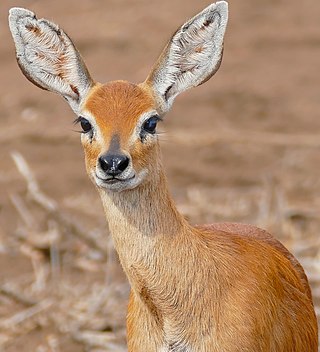
Raphicerus is a genus of small antelopes of the tribe Neotragini.
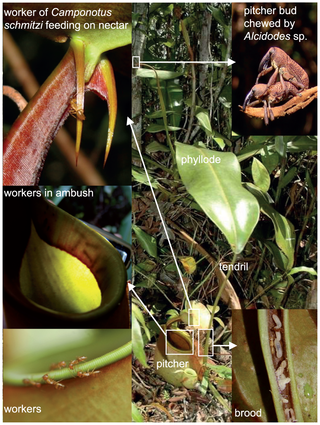
Colobopsis schmitzi, synonym Camponotus schmitzi, is a species of ant native to Borneo, which is commonly known as the diving ant, swimming ant or pitcher-plant ant, due to their habit of diving into the digestive fluids of their plant host Nepenthes bicalcarata. They are endemic to the island of Borneo.
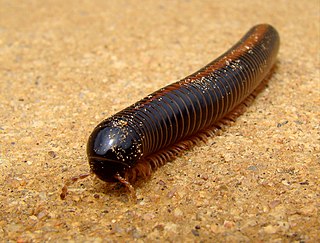
Archispirostreptus gigas, known as the giant African millipede or shongololo, is the largest extant species of millipede, growing up to 33.5 centimetres (13.2 in) in length, 67 millimetres (2.6 in) in circumference. It has approximately 256 legs, although the number of legs changes with each molting so it can vary according to each individual.

Axiocerses amanga, the bush scarlet, is a butterfly of the family Lycaenidae. It is found in Sub-Saharan Africa.
Camponotus reburrus is a species of carpenter ants in the subfamily Formicinae. It is known only from northeastern Ecuador. C. reburrus apparently has an obligatory relationship with the ant plants Cecropia membranacea, Cecropia herthae and Cecropia marginalis. The workers are relatively small and hairy, it does not appear to have major workers. It is similar to Camponotus balzani which also lives in Cecropia spp..

Camponotus herculeanus is a species of ant in the genus Camponotus, the carpenter ants, occurring in Northern Eurasia, from Norway to Eastern Siberia, and North America. First described as Formica herculeana by Linnaeus in 1758, the species was moved to Camponotus by Mayr in 1861.

The golden tail sugar ant is a species of ant in the genus Camponotus. It is native to eastern Australia and was described by Gustav Mayr in 1862.

Camponotus maculatus is a species of carpenter ant.
Camponotus thraso is a species of carpenter ant. The type species is found from Sri Lanka.

The black-headed sugar ant, also known as the brown sugar ant, is a species of Formicinae ant endemic to Australia. Found throughout most states, the species is a member of the genus Camponotus, a cosmopolitan genus of ants commonly known as carpenter ants. It was formally described and named by British entomologist Frederick Smith in 1858. These ants are characterised by their black head, reddish-brown mesosoma and black gaster, which can change in colour.
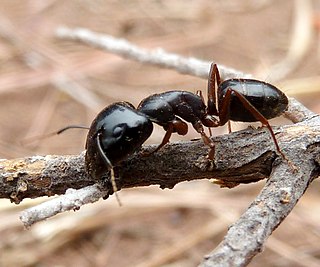
Camponotus empedocles is a large and dark species of carpenter ant with an extensive range in the Afrotropics.

Camponotus niveosetosus, commonly known as the hairy sugar ant, is one of the smaller species of sugar ant. It is native to an extensive region in the eastern Afrotropics.

The Namib Desert dune ant, is a large ant species distinguished by white and black symmetrical stripes and markings on its hairy abdomen. It has an average mass of 45 milligrams (0.0016 oz). It is classified within the carpenter ant genus, a large group of more than 1,000 known species, many of which are associated with forested habitats in America and elsewhere. However C. detritus inhabits the hot dry dunes of the hyper-arid central Namib Desert in Southern Africa. Like many other ant species, it obtains its food and moisture by climbing the stalks of plants and drinking honeydew from scale insects, which themselves feed on shrubs and other perennial plants. It will also feed on dead insects. The nests of this species, located amongst perennial plant roots, are systems of tunnels and chambers between 100–400 millimetres (3.9–15.7 in) deep. Nests can reach temperatures of 35 °C (95 °F) in summer, though they are much cooler in winter, typically 20–23 °C (68–73 °F). Nests are often lined with detritus - hence the binomial Latin name of the species. Each colony contains a single queen.

Myrmicaria natalensis, commonly known as the Natal droptail ant, is a species of ant with an extensive range in the Afrotropics. It has been recorded from Guinea, Ivory Coast, Uganda, DRC, Tanzania, Mozambique, Angola, Namibia and South Africa, where the type was obtained. Like others in its genus, it has a distinctive down-curved gaster and spines on the mesosoma.

Justicia petiolaris is a plant species in the family Acanthaceae. It is a perennial or rhizomatous geophyte native to Mozambique, Eswatini, and eastern and southern South Africa.

Camponotus dumetorum is a species of carpenter ant native to North America. They are related to other species from the subgenus Tanaemyrmex in western North America such as C. semitestaceus and C. vicinus. C. dumetorum are primarily nocturnal and form nests underground. Like other select ant species native to California, their populations have been displaced with the introduction of Argentine ants.
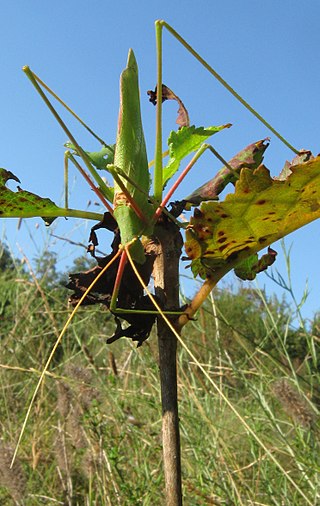
Acrometopa is a genus of bush crickets in the subfamily Phaneropterinae; It is typical of the tribe Acrometopini. Species in this genus are found in south-eastern Europe and the Middle East.

Leptacris is a genus of grasshoppers in the family Acrididae, subfamily Hemiacridinae; species have been recorded from Africa and tropical Asia.



















